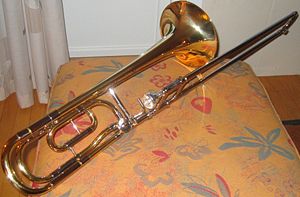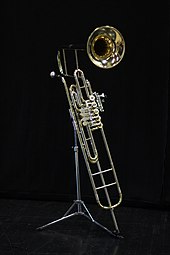
A brass instrument is a musical instrument that produces sound by sympathetic vibration of air in a tubular resonator in sympathy with the vibration of the player's lips. Brass instruments are also called labrosones or labrophones, from Latin and Greek elements meaning 'lip' and 'sound'.

The euphonium is a medium-sized, 3 or 4-valve, often compensating, conical-bore, tenor-voiced brass instrument that derives its name from the Ancient Greek word εὔφωνος euphōnos, meaning "well-sounding" or "sweet-voiced". The euphonium is a valved instrument. Nearly all current models have piston valves, though some models with rotary valves do exist.

The pitch of a brass instrument corresponds to the lowest playable resonance frequency of the open instrument. The combined resonances resemble a harmonic series. The fundamental frequency of the harmonic series can be varied by adjusting the length of the tubing using the instrument's valve, slide, key or crook system, while the player's embouchure, lip tension and air flow serve to select a specific harmonic from the available series for playing. The fundamental is essentially missing from the resonances and is impractical to play on most brass instruments, but the overtones account for most pitches.

The term sackbut refers to the early forms of the trombone commonly used during the Renaissance and Baroque eras. A sackbut has the characteristic telescopic slide of a trombone, used to vary the length of the tube to change pitch, but is distinct from later trombones by its smaller, more cylindrically-proportioned bore, and its less-flared bell. Unlike the earlier slide trumpet from which it evolved, the sackbut possesses a U-shaped slide with two parallel sliding tubes, rather than just one.

The trombone is a musical instrument in the brass family. As with all brass instruments, sound is produced when the player's vibrating lips (embouchure) cause the air column inside the instrument to vibrate. Most brass instruments use valves to alter the pitch, but trombones have a telescoping slide mechanism instead. Many modern trombone models also have a valve attachment which lowers the pitch of the instrument. Variants such as the valve trombone and superbone have three valves similar to those on the trumpet.

The trumpet is a brass instrument commonly used in classical and jazz ensembles. The trumpet group ranges from the piccolo trumpet with the highest register in the brass family, to the bass trumpet, which is pitched one octave below the standard B♭ or C Trumpet.

The tuba is the lowest-pitched musical instrument in the brass family. As with all brass instruments, the sound is produced by lip vibration – a buzz – into a mouthpiece. It first appeared in the mid-19th century, making it one of the newer instruments in the modern orchestra and concert band. The tuba largely replaced the ophicleide. Tuba is Latin for "trumpet".

A transposing instrument is a musical instrument for which music notation is not written at concert pitch. For example, playing a written middle C on a transposing instrument produces a pitch other than middle C; that sounding pitch identifies the interval of transposition when describing the instrument. Playing a written C on clarinet or soprano saxophone produces a concert B♭, so these are referred to as B♭ instruments. Providing transposed music for these instruments is a convention of musical notation. The instruments do not transpose the music; rather, their music is written at a transposed pitch. Where chords are indicated for improvisation they are also written in the appropriate transposed form.
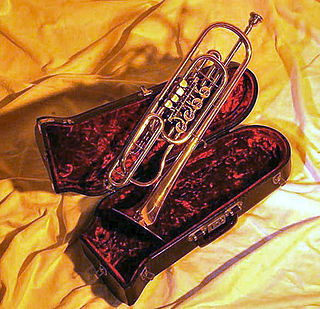
The bass trumpet is a type of low trumpet which was first developed during the 1820s in Germany. It is usually pitched in 8' C or 9' B♭ today, but is sometimes built in E♭ and is treated as a transposing instrument sounding either an octave, a sixth or a ninth lower than written, depending on the pitch of the instrument. Having valves and the same tubing length, the bass trumpet is quite similar to the valve trombone, although the bass trumpet has a harder, more metallic tone. Certain modern manufacturers offering 'valve trombones' and 'bass trumpets' use the same tubing, valves, and bell, in different configurations - in these cases the bass trumpet is virtually identical to the valve trombone.
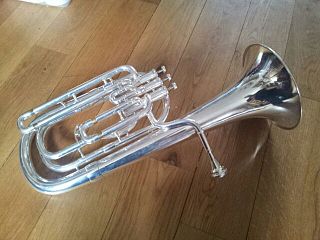
The baritone horn, or sometimes just called baritone, is a low-pitched brass instrument in the saxhorn family. It is a piston-valve brass instrument with a bore that is mostly conical but it has a narrower bore compared to the similarly pitched euphonium. It uses a wide-rimmed cup mouthpiece like that of its peers, the trombone and euphonium. Like the trombone and the euphonium, the baritone horn can be considered either a transposing or non-transposing instrument.
Contrabass refers to several musical instruments of very low pitch—generally one octave below bass register instruments. While the term most commonly refers to the double bass, many other instruments in the contrabass register exist.

The valve trombone is a brass instrument in the trombone family that has a set of valves to vary the pitch instead of a slide. Although it has been built in sizes from alto to contrabass, it is the tenor valve trombone pitched in B♭ which has seen the most widespread use. The most common valve trombone has three piston valves, and plays just like a trumpet but an octave lower. They are built in either short or long form.

The cimbasso is a low brass instrument that developed from the upright serpent over the course of the 19th century in Italian opera orchestras to cover the same range as a tuba or contrabass trombone. The modern instrument has four to six rotary valves, a forward-facing bell, and a predominantly cylindrical bore. These features lend its sound to the bass of the trombone family rather than the tuba, and its valves allow for more agility than a contrabass trombone. Like the modern contrabass trombone, it is most often pitched in F, although models are made in E♭, and occasionally low CC or BB♭.
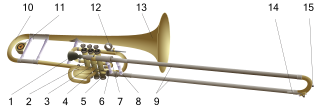
The superbone is a hybrid tenor trombone in B♭ that has both a slide like a regular trombone and a set of valves like a valve trombone.
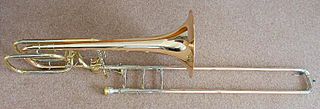
The bass trombone is the bass instrument in the trombone family of brass instruments. Modern instruments are pitched in the same B♭ as the tenor trombone but with a larger bore, bell and mouthpiece to facilitate low register playing, and usually two valves to fill in the missing range immediately above the pedal tones.

The alto trombone is the alto member of the trombone family of brass instruments, smaller than the tenor trombone. It is almost always pitched in E♭ a fourth higher than the tenor, although examples pitched in F are occasionally found. The alto trombone was commonly used from the 16th to the 18th centuries in church music to strengthen the alto voice, particularly in the Mass. Alto trombone parts are usually notated in alto clef.

Marching brass instruments are brass instruments specially designed to be played while moving. Most instruments do not have a marching version - only the following have marching versions:
The contrabass trombone is the lowest instrument in the trombone family of brass instruments. A true contrabass trombone is pitched an octave below the B♭ tenor trombone. However, since the late 20th century, it has largely been supplanted by a bass-contrabass instrument pitched in F, a perfect fourth below the tenor trombone. Wagner first specified the contrabass for his Der Ring des Nibelungen opera cycle in the 1870s, and it has since appeared occasionally in large orchestral works without becoming a permanent member of the modern orchestra. In the 21st century it has enjoyed something of a revival, particularly in film and video game soundtracks.

The saxotromba is a valved brass instrument invented by the Belgian instrument-maker Adolphe Sax around 1844. It was designed for the mounted bands of the French military, probably as a substitute for the French horn. The saxotrombas comprised a family of half-tube instruments of different pitches. By about 1867 the saxotromba was no longer being used by the French military, but specimens of various sizes continued to be manufactured until the early decades of the twentieth century, during which time the instrument made sporadic appearances in the opera house, both in the pit and on stage. The instrument is often confused with the closely related saxhorn.

The soprano trombone is the soprano instrument in the trombone family of brass instruments. It is usually pitched in B♭ an octave above the tenor trombone, and has a bore, bell and mouthpiece similar to the B♭ trumpet. Although modern instruments are made, the soprano remains a rare trombone seldom written for, compared to the tenor, bass, or even the uncommon alto trombone.




